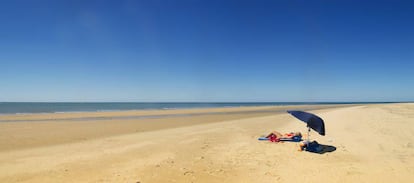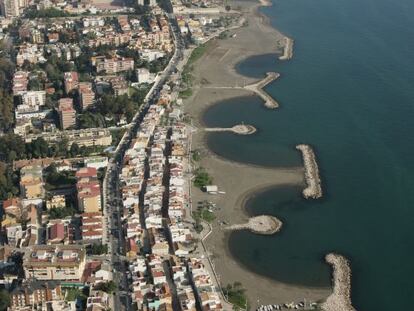The parts of Spain’s coastline developers would most like to get their hands on
Greenpeace report identifies 53 unspoiled areas of Spanish coastline at risk of future development
For many people, the first image that springs to mind when they think of the Spanish coastline is that of the crowded beaches of popular tourist resorts such as Benidorm, or the more built-up areas of the vacation island of Mallorca.

But some stretches of Spain’s 7,880-kilometer coastline have been spared by the decades of rampant development spurred on by both mass tourism and property speculation. It is these remnant areas that Greenpeace warns could be the target of a possible new “golden age of property” in Spain.
In a new report looking at coastal development in the country from 1987 to 2011, the environmental group has identified 53 areas it believes are the most “desirable” for builders, calling for greater protection for these housing-free zones before the bulldozers roll in. The Balearic and Canary Islands are included, and no province is spared, although the list is heavily weighted towards the country’s south and east.
We have to look at these areas really closely and treat them with care Pilar Marcos, Greenpeace
The areas selected by Greenpeace as being most at risk all share several features in common. They are stretches of coast that border protected areas, have good road links and are easy to access. They also enjoy either only limited environmental protection or no safeguards at all.
“We have to look at these areas really closely and treat them with care,” says Pilar Marcos, who is heading Greenpeace’s “Protección a toda costa” (Protection at any cost) campaign, which aims to boost the environmental safeguards for those areas it believes are under threat.
Among the group’s demands is that at-risk coastal areas currently managed via the European Union’s Natura 2000 environment protection network be reclassified as protected spaces as per Spanish law. This would see them be subject to more stringent environmental safeguards.
The new Greenpeace report identifies the Andalusian provinces of Cádiz and Málaga as the greatest victims of frontline coastal overdevelopment. It notes that areas including the coastal stretches encompassing Chipiona-Sanlúcar and Barbate-Zahara in Cádiz, as well as Vélez-Málaga in Malaga, are among the five most-at-risk zones in terms of future development.

In the hugely popular province of Alicante, Vila Joiosa makes the Greenpeace list, while in Valencia province, the area around Denia – popular as a beach destination for people from Madrid – is included. The environmental group also highlights the Ebro Delta area in Catalonia as being at risk.
In the Balearics, the interior of the island of Formentera and the southwest of Ibiza are included. Seven zones in the Canary Islands are considered under threat including the north of Gran Canaria, while at the other end of the country, the Galician areas of Boiro and Finisterre have been put on the watchlist.
The Greenpeace study, based on an investigation of 21,000 land plots nationwide, also shows that 31.8% of publicly owned land in Spain has been built on. In terms of the 10 kilometers closest to the coast, Barcelona province heads the rankings with 31.7% of public land in that zone having been developed. In second-placed Alicante that figure is 21.9% while in Malaga it is 20.5%.
Huelva province, in Andalusia, has the most protected coastline with a total of 61.5%, while Tenerife is second with 59.7% and Las Palmas is next with 51.6%.
English version by George Mills.

Tu suscripción se está usando en otro dispositivo
¿Quieres añadir otro usuario a tu suscripción?
Si continúas leyendo en este dispositivo, no se podrá leer en el otro.
FlechaTu suscripción se está usando en otro dispositivo y solo puedes acceder a EL PAÍS desde un dispositivo a la vez.
Si quieres compartir tu cuenta, cambia tu suscripción a la modalidad Premium, así podrás añadir otro usuario. Cada uno accederá con su propia cuenta de email, lo que os permitirá personalizar vuestra experiencia en EL PAÍS.
¿Tienes una suscripción de empresa? Accede aquí para contratar más cuentas.
En el caso de no saber quién está usando tu cuenta, te recomendamos cambiar tu contraseña aquí.
Si decides continuar compartiendo tu cuenta, este mensaje se mostrará en tu dispositivo y en el de la otra persona que está usando tu cuenta de forma indefinida, afectando a tu experiencia de lectura. Puedes consultar aquí los términos y condiciones de la suscripción digital.
More information
Archived In
Últimas noticias
From Andorra to Gibraltar, a black market for Ozempic exploits its success: ‘They’re the most sought-after products in the world’
From Hungary’s Orbán to Chile’s Kast: How Trump helps turbo charge the far right
Magnets in their heads: How some animals guide themselves using the Earth’s magnetic field
The brief rise and retreat of Generation Z in Mexico
Most viewed
- Why we lost the habit of sleeping in two segments and how that changed our sense of time
- Trump’s obsession with putting his name on everything is unprecedented in the United States
- Charles Dubouloz, mountaineering star, retires at 36 with a farewell tour inspired by Walter Bonatti
- The Florida Keys tourist paradise is besieged by immigration agents: ‘We’ve never seen anything like this’
- Living in a motorhome due to soaring housing prices in Madrid: ‘I got used to it quickly, but I don’t idealize it’










































